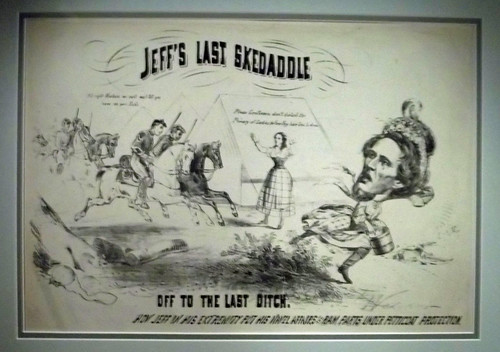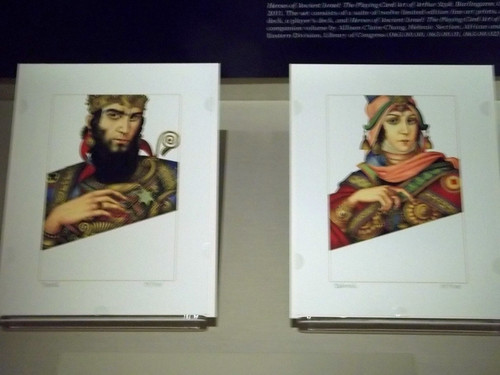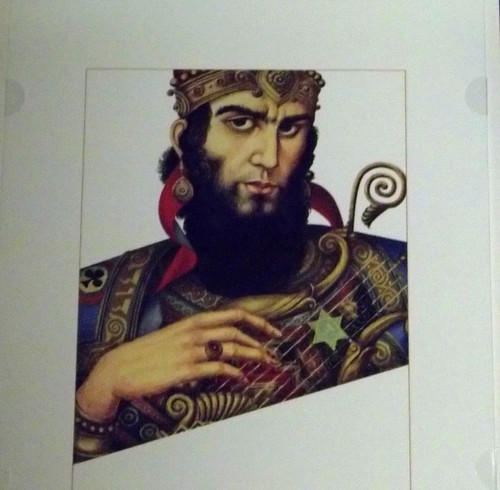Politics & Prose
Wednesday, May 20, 2015
May 22: Battle Lines: A Graphic History of the Civil War
Politics & Prose
Monday, July 01, 2013
International Ink extra: Gettysburg: The Graphic History
The story is so big and complex that it doesn't fit well into 96 pages. Vansant does a competent job of explaining the preparations before the battle, the three days of the battle and the aftermath, including the full text of Lincoln's Gettysburg Address which dedicated the Union cemetery. He's obviously used reference photographs, and his artwork makes the famous people recognizable, if a bit stiff. He approaches the story chronologically, and one can get an idea of how the battle unfolded, but the book remains rather dry. Given his young adult audience, Vansant draws a minimum of bloodshed. When he writes, "Down below, General Hood's left arm was shattered by a shell burst," he draws Hood and his horse blinded and pushed to one side by the explosion and only colors them with a golden wash. I do not think most readers would actually want any more graphic detail than that, but Vansant's decision does sap some of the essence out of the story. His need to jump from one small segment of the battle to the next, unavoidable as it may be, has the same effect.
The story appears to be factually correct, although some items such as drawing Confederate General Lewis Armistead advancing with his hat speared on his sword aren't explained. Perhaps he thought sharpshooters would aim for his hat? A final round of proof-reading would have avoided mistakes such as "Choked with emotion because he did not want to make this attack, Longstreet nearly nodded." (p. 81) Presumably 'merely' is meant, not 'nearly' since a near nod is not much of a military command.
In conclusion, this book is most likely to appeal to a boy who already has an interest in the Civil War or military history, and is a perfectly reasonable starting place for someone looking at the vast amount of Gettysburg literature.
Still coming next - Tommysaurus Rex.
Friday, March 01, 2013
More cartoons on view at Library of Congress



In the Words Like Sapphires: 100 Years of Hebraica at the Library of Congress, 1912–2012 exhibit, there's two original paintings by Arthur Szyk for playing cards.


Down to Earth: Herblock and Photographers Observe the Environment is only open for three more weeks.
Monday, January 03, 2011
January 6: Civil War political cartoons at Newseum
| Here's a tip from Warren Bernard. This is a National Archives event and hopefully will be free, but it doesn't specify on their calendar yet. Thursday, January 6, at 7 p.m. Presented at the Newseum's Walter and Leonore Annenberg Theater 555 Pennsylvania Ave., N.W. Washington, D.C.
Political Cartoons of the Civil War and Their Role in Shaping History How do political cartoons from the Civil War era reveal what Americans thought about the war and how they participated in the politics of the day? Join us for an illustrated discussion focusing on political cartoons—whether humorous, clever, or scathing—and their role in providing insight into the economic, political and moral issues surrounding the Civil War. Featured will be both Union and Confederate political cartoons. Moderated by Harold Holzer, co-author of The Lincoln Image: Abraham Lincoln and Popular Print, panelists include Joshua Brown, author of Beyond the Lines: Pictorial Reporting, Everyday Life, and the Crisis of Gilded Age America, John Adler, who compiled for the online resource HarpWeek, Illustrated Civil War Newspapers and Magazines, and Richard West, co-author of William Newman: A Victorian Cartoonist in London and New York.
The National Archives Experience is pleased to present tonight's program in partnership with the Newseum. |
Tuesday, April 27, 2010
National Archives' Civil War manga style
Monday, February 15, 2010
Marvel's Civil War plays out on Post blog
Friday, December 05, 2008
Dec 8: Swann fellow speaks on Civil War prints
Of possible interest to those in the Washington, D.C. area -- an invitation to a public lecture by Mazie Harris, Swann award winner, on Civil War era chromolithographs created by Henry Louis Stephens, a major illustrator and caricaturist for Vanity Fair. Her talk, entitled, "A Colorful Union: The Development of Union Patriotism in Henry Louis Stephens’ 1863 Chromolithographs," will be on Monday, Dec. 8, 2008, at noon in Dining Room A, 6th floor, Madison Building, Library of Congress, 101 Independence Avenue SE, Washington, D.C.
Unfortunately I probably can't make this one.
Monday, November 17, 2008
Dec 8: Swann fellow speaks on Civil War prints
101 Independence Avenue SE
Washington DC 20540
Phone: (202) 707-2905
Fax: (202) 707-9199
November 17, 2008
Public contact: Martha Kennedy (202) 707-9115, mkenn@loc.gov
MAZIE HARRIS TO DISCUSS CIVIL WAR ERA CHROMOLITHOGRAPHS BY HENRY LOUIS STEPHENS AT LIBRARY OF CONGRESS, DEC. 8
Swann Foundation grantee Mazie Harris, in a lecture at the Library of Congress, will discuss the Civil War Era chromolithographs by Henry Louis Stephens, the primary illustrator for the satirical New York journal Vanity Fair.
Harris will present the lecture, “A Colorful Union: The Development of Union Patriotism in Henry Louis Stephens’ 1863 Chromolithographs,” at noon on Monday, Dec. 8, in Dining Room A on the sixth floor of the James Madison Building, 101 Independence Ave. S.E., Washington, DC.
In her illustrated talk, Harris will describe her research on the work of Stephens (1824-1882), a caricaturist as well as illustrator. She will draw on examples of his imagery from works held in the Library’s Marian S. Carson Collection and other source material in the Prints and Photographs Division.
The Emancipation Proclamation compelled Stephens to reconsider his previously virulently anti-abolitionist propaganda, according to Harris. In her talk, she will contend that after Abraham Lincoln’s groundbreaking executive orders in 1862 and 1863, Stephens deployed color printing and caricature in an attempt to reformulate views of race relations in the North and mobilize military enlistment.
Harris will analyze Stephens’ visual narratives by considering hand-written directions to the printer that the illustrator scrawled on the margins of each sketch for the series. These technical notes on color, which could be regarded simply as artistic instructions, when carefully examined and assessed, make explicit the particular political ideology of the prints.
Harris is a Ph.D. candidate in the Department of the History of Art and Architecture at Brown University. She completed an M.A. in art history from Boston University, and became interested in the work of Henry Louis Stephens while working as a curatorial assistant in the Agnes Mongan Center for the Study of Prints, Drawings and Photographs in Harvard University’s Fogg Art Museum.
This presentation is part of continuing activities of the Caroline and Erwin Swann Foundation for Caricature and Cartoon to support the study, interpretation, preservation and appreciation of original works of humorous and satiric art by graphic artists from around the world. The foundation is overseen by an advisory board composed of scholars, collectors, cartoonists and Library of Congress staff members.
The foundation strives to award one fellowship annually (with a stipend of up to $15,000) to assist scholarly research and writing projects in the field of caricature and cartoon. For 2008-2009, because of an unusually large number of strong applications, the foundation’s advisory board chose to support five applicants with smaller awards instead of selecting a single recipient of the fellowship.
Applications for the academic year 2009-2010 are due Feb. 13, 2009. For more information about the fellowship, visit www.loc.gov/rr/print/swann/swannhome/ or email swann@loc.gov.
# # #
PR08-216
11/17/08
ISSN: 0731-3527


